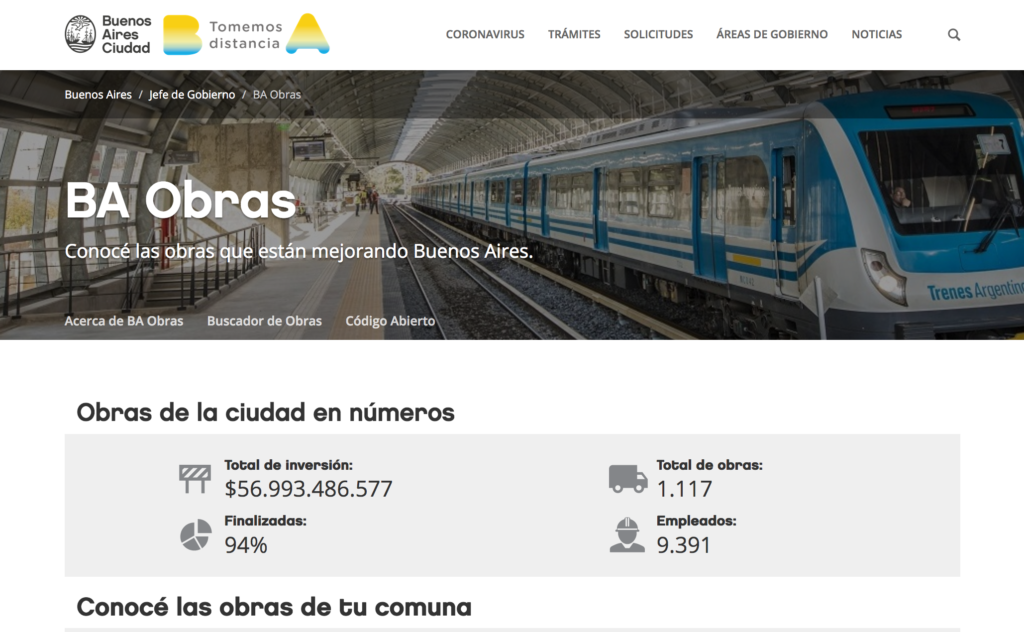What is it really like opening up government procurement? Lessons from an insider

Get a behind-the-scenes look at the reality of transforming infrastructure procurement with our new Open Contracting for Infrastructure Manager Mariana San Martin, who has gotten deep into of public sector reform in Argentina, first as a senior staffer in the City Government of Buenos Aires’ Ministry of Urban Development and Transport and then as the Provincial Director of Open Government at the Province of Buenos Aires.
Public infrastructure procurement can often be messy, with many projects and subprojects, contracts and sub-contracts, scattered across different systems and government agencies. More often than not, projects lack unique identifiers, which makes it difficult to track and monitor performance either across agencies or even within a single ministry. In Argentina, there is an added complexity: the extremely high levels of inflation cause prices to fluctuate drastically, making it even more difficult to manage contracts and monitor performance or understand reasons for variations.
I had the privilege of driving through open government and open contracting for infrastructure reforms to try to cut through all this complexity and create better knowledge of how taxpayers’ money is spent.
City of Buenos Aires
Argentina’s capital Buenos Aires is the country’s richest, most developed territory, with 3 million people. Relatively speaking, the City Government of Buenos Aires (GCBA) has some of the best processes in place, along with an enviable budget. It is a reformist government eager for innovation. Despite this, coordination among the City’s agencies could be improved and there is a lack of data to make evidence-based decisions. Alas, this need is not always acknowledged by public officials. In my early meetings on opening up government, many, if not most senior officials insisted that “everything is already being published”. They were referring to bidding documents which were only available in PDF format, and were virtually impossible to find unless you already knew the specific document number. Thus, began my long journey to deliver open government reforms in Argentina.
In 2016, the City Government made a courageous decision to develop BA Obras, the first open government platform for infrastructure in the city, which would publish open data on over 900 public works and their related contracts in a simple and interactive way. We planned to turn on the “floodlights” in the hope that it would help to increase efficiency, improve coordination between agencies and reduce potential irregularities.
The platform is now live at: https://www.buenosaires.gob.ar/baobras
The open source platform, which covers all 900 of the City’s infrastructure projects, has inspired similar projects elsewhere in Argentina and in cities in Mexico and Brazil.

Province of Buenos Aires
Now let’s jump to a completely different reality: the Province of Buenos Aires is a huge territory facing immense challenges without adequate resources. The province’s small budget is almost fully allocated with 85% on overheads (wages, pensions, money given to municipalities, etc). This means that only 15% remains to pursue broader policy goals be it for infrastructure, medicines or school books. This is nowhere near enough.
According to the Provincial Ministry of Infrastructure in January 2018, the infrastructure deficit in the province was US$96 billion or approximately twice the total annual budget of the Province. Assuming we were to allocate only 6% of the budget to infrastructure, it would take 50 years to eliminate the deficit!
Citizens in the province are not receiving the life saving infrastructure that they need: some 24% of the population is at risk of flooding, 50% of the population lack access to proper sanitation, 25% are without access to clean water, 70% of the road network is unpaved, 96% of the hospitals have structural building problems, 36% of households remain unconnected to a working gas network and there are 1,600 slums.
The Province Government decided that a radical transformation was needed to address these devastating conditions. In 2018, we suggested to standardize data on current infrastructure projects in the territory in an attempt to improve internal efficiency in processes and coordination between agencies. And in this way, saving time and money whilst delivering better results for citizens. Implementing an open government platform for infrastructure seemed like a great fit.
But the intersection of urgency, resources (or lack of) and ‘bad’ data affected our execution. Often when we talk about open data, we forget that many institutions lack the sophistication, technology or processes to be able to deliver open data reforms at scale. I remember having to meet with each and every one of the 135 mayors from each municipality in the province: my team and I had to take detailed notes of each and every infrastructure project in the municipality in order to turn it into usable, machine readable data. They just did not have the capacity to digitize the information, so we had to roll up our sleeves and do it for them. It was the only way to move forward with the proposed infrastructure transparency platform.
The platform, which covers all 8,000 infrastructure projects in the Province, is ready but unfortunately it hasn’t been published yet. But the development of the platform has already improved the government’s internal processes. As with the City Government, the lead, standardization and systematization of data in the Province Government started in one team but spilled out to the broader organization, contributing to the improvement of data quality and processes on a larger scale.
Road blocks
Successfully executing such reforms is no easy feat, even in a middle income richer G20 member. The platforms didn’t exist yet, they weren’t endorsed by regulations, and would be considered ‘sensitive’ by many, so it was a challenge to convince public officials to support them. We faced other big hurdles, including poor data quality and a lack of standardization across the different agencies’ various data (and even paper-based) systems. Government is full of urgent and competing agendas, so to keep the open agenda a priority for political leaders, we knew we had to make a good case, keep it low budget and take the lead on technical tasks. In the Province Government, we also faced the challenge of unclear responsibilities and issues in coordinating with other levels of government in the same territory.
7 lessons for reformers
To achieve our ambitious open contracting goals in the City of Buenos Aires, we had to be persistent and make concessions in the beginning, making sure that the changes we made weren’t easily reversed. It is not always the right moment for reforms, and in political environments there are times when some agendas can be advanced very quickly (and you have to be fast and take advantage of it!) and others when you cannot. During the latter, though, you can already build your case so that when the opportunity comes, the project is ready.
- High-level political buy-in: in both cases the endorsement of the highest government authorities allowed the projects to move forward as a priority across teams. As it is a sensitive agenda and not a priority, it is fundamental to achieve high-level political support. As well, a good strategy is to be aware of windows of opportunity, moments where political leaders will be looking for visibility through the work done.
- Some changes are easier: it’s easier to implement these changes in a government where processes and systems are well-established. The starting point is clearer and the benefits of standardization are more evident. This was the case of the City as opposed to the Province.
- Champions in government: you must have someone who will push this agenda from the inside. If this person is in a strategic political place, your chances of success will be greater. Having strategic allies in the government is critical too.
- Have one lead team: this is central for coordinating the work, closely monitoring the project and taking responsibility for tasks, as others involved already have competing priorities from their day to day duties.
- Timing: Electoral periods and specific political moments will have a huge impact on this agenda, and political will to disclose more or less information. Unfortunately, this was the reason why the platform in the Province never saw the light of day despite being completed.
- Purpose of publishing data: the staff involved must understand why this will be helpful for them. Showing impact on chosen priorities can be one reason.
- External allies and international recognition: a change of mindset towards openness sometimes takes time inside governments. Having allies such as international organizations, civil society or media can help that change to happen. In the case of the Province, becoming an affiliate member of an international and legitimate organization such as CoST helped for internal buy-in, as it could potentially help with visibility, legitimacy and resources.
Where do we go next?
The City of Buenos Aires is in a unique position. This is the perfect moment to take the next step from data publication to data use and from there to delivering reform and transforming public services. The BAObras platform must be put to good use and that means that the ‘good’ data must be actively and regularly analysed to identify irregularities or discrepancies so that ideas or solutions for improvement can be implemented. In doing so, the City Government will send a signal to its citizens that it is serious about modernization and committed to improving public services which will build trust and integrity. Non-state stakeholders must be encouraged and trained to use data to monitor progress and performance. Open forums where citizens can discuss their findings with their public officials are also key to inclusive and effective government.
There is a lot data can tell us, particularly well-structured data using powerful tools like the OC4IDS and OCDS open data schemas, and I would love to see those stories being told in a meaningful way and to see these important changes being made. As leader of this agenda, the City can add data standards to the “how to” guidance they already share with other governments through the open source platform.
The Province of Buenos Aires still has a long path ahead of it but there are many low hanging fruits for success. They can publish and operationalize the infrastructure transparency platform “Obras Abiertas”, that is already developed and ready to go, including data in OC4IDS format. The Province has a lot to win from being more efficient and improving processes, as their needs are still enormous and resources scarce. As a second phase, I would also like to see measures for data use and reforms to be implemented.
Infrastructure projects will be an increasing urgent challenge in the post COVID-19 world. We need more and better data to meet this challenge, and this is where open contracting can help. In my new role at the Open Contracting Partnership, I pledge to continue supporting the City and Province of Buenos Aires and provide all the necessary guidance, encouragement and technical support to make this open government dream a reality.